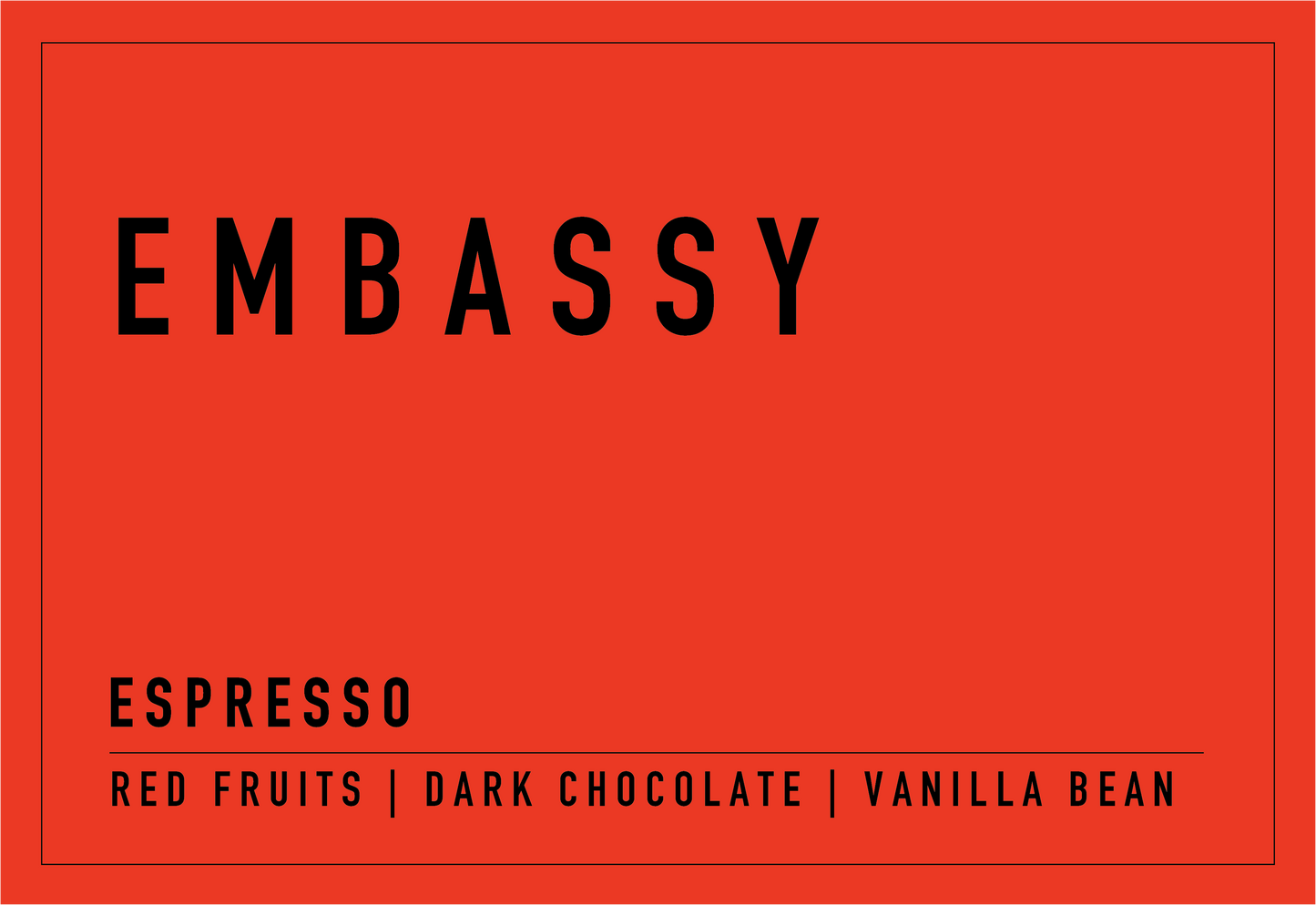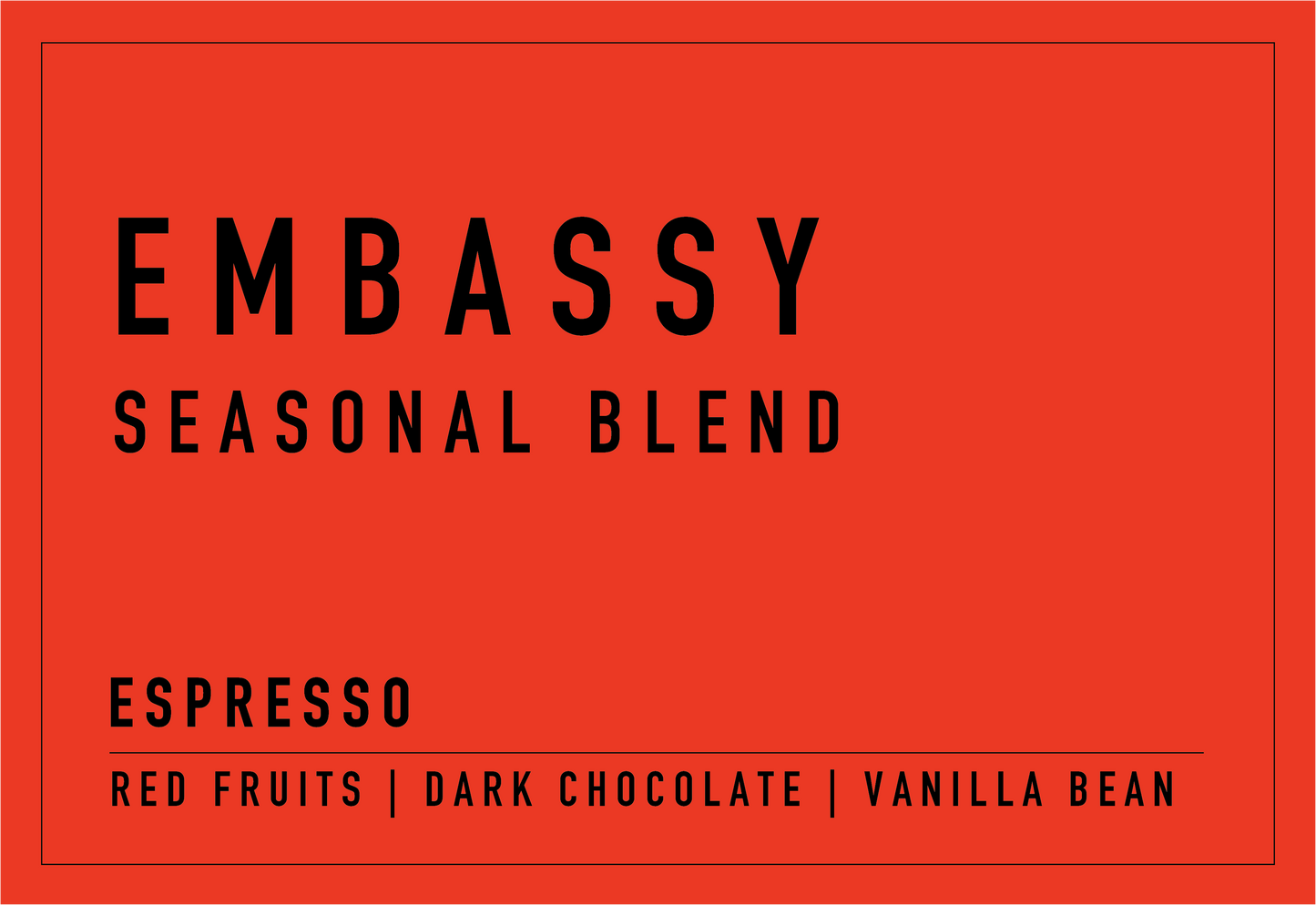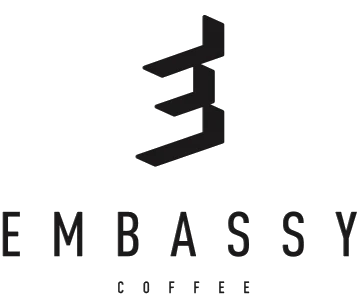CoffeeEmbassy
Embassy Blend
Embassy Blend
Couldn't load pickup availability
What is Embassy? - Embassy Blend, our original espresso blend, has been with us since the beginning. Created as a modern Espresso Blend, we focus on sourcing fresh crop coffees in line with the harvest seasons; the components change from time to time so we can consistently offer you a complex, fresh and exciting drink. We roast Embassy to be suitable for both black and white coffees.
You can find our namesake blend in the hopper at our Cellar Door and being served up at some of Christchurch's best coffee shops, cafes and restaurants.
A note from James, Head of Coffee: Our mission at Coffee Embassy is to be as transparent as possible. We enjoy sharing information about the coffee you are drinking and help educate about coffee. Embassy blend is currently made up of Brazil Araponga, Colombia Huila Reserve, and Ethiopia Sidama Dara. Before we get stuck into the details of the origins I would like to go over a few of the coffee terms/language we use every day. If you would like to know more about each of the coffees in this blend, we have provided some more in-depth information in the tabs below, alternatively we are always happy to chat!
Score: 85.5
Flavour Profile - Red Fruits, Dark Chocolate, Vanilla Bean
Coffee Terms/Language
What is a Seasonal Blend? A Seasonal Blend is to offer an exciting and complex coffee that is linked up with the coffee harvest season. This allows us to bring you a coffee that is always fresh and flavour driven.
Cup/Quality Score: Scoring coffee is used to define the quality of the coffee. Scores are given to the individual origins. To be considered “Specialty” a coffee must score a minimum of 80/100. Most Specialty coffees score between 80 – 87. Only a few outstanding coffees will score higher than this.
Roast Degree/Type/colour/style: Back in the days of old, coffee roasts were (and still are by some) only described as being light, medium and dark. These descriptions are still relevant to a point but coffee is no longer as straight forward. These days ones interpretation of colour can vary from roaster to roaster. We try to triangulate roast degree (Temperature) Colour and Development of the roast not just the colour (as different origins can colour differently)
Styles: Spot Seasonal Espresso, Modern Espresso, Classic Espresso, Filter.
The Origins
Now we can get stuck into the coffees themselves.
Brazil: Araponga
Using since: March 2023
Score: 84.5 Flavour
Profile: Milk Chocolate, Apple, Macadamia, Toffee
Process: Natural
The Araponga region is a micro-region within the Matas de Minas in the estate of Minas Gerais. The region is embraced by the Atlantic forest, which makes it very suitable for the production of specialty coffees. Another characteristic of the Araponga region is its microclimate. Sometimes a farm can have different microclimates from one crop to another. This contributes to different nuances of flavour in the cup. This region is privileged with high mountains that lead to a range of temperatures and levels of humidity creating the perfect place to grow amazing coffees.
This coffee went through the following process: from the harvest, it was taken to the washing machine for separation by density. Then, cherries were taken to the suspended beds, which remained open for the first two days. In these first two days, the coffee layers were kept thicker to stimulate the natural fermentation of the fruits. After two days, when the moisture content was lower, the layers were thinned and the suspended bed was covered, to ensure a slow and uniform drying. The rest of the drying took an average of 10 days.
___
Colombia: Huila Reserve
Using Since: November 2023
Score: 85
Flavour Profile: Stone fruits, Caramel, Citrus
Process: Washed
The Huila Reserve program encourages farmers to improve the quality of the coffee they produce through improved farming practices and is rewarded for their efforts with better premiums. All the selected farmers in our program deliver their coffees directly to our collection warehouse in Huila. The coffees are then carefully assessed to ensure they fulfill all the requirements in terms of grading and quality. Every lot is cupped separately and then are blended depending on the characteristics of each one. Once coffees are approved by our quality control team, farmers are paid the next day for their coffees. This lot is composed by smallholders from Isnos, Pitalito, Acevedo, Iquira, Palermo, La Plata, Oporapa and La Argentina, Huila. The average size farm is 2 hectares
___
Ethiopia: Dara
Using Since: October 2024
Score: 86
Flavour Profile: Vanilla Cream, Strawberries, Cinnamon
Process: Natural
This coffee is cultivated in Sidama Dara, its soil is fertile and climate conditions are perfect for growing exceptional coffee. The dry processing station is 2.8 hectares with 200 drying beds, the coffee is sourced from small farmers who grow heirloom coffees near the station area. This coffee is naturally processed, which means that the ripe cherry is left to dry with all of its skin and mucilage attached. The coffee is sun- dried for 10–20 days until it achieves the ideal moisture content. This results in a sweeter and fruitier cup profile. After the cherries have dried to the desired moisture level, they are stored in a cool place for a few weeks. This resting period helps to develop the flavours within the beans. Once the resting period is complete, the dried cherries are hulled to remove the dried outer skin and pulp.
After picking the perfect ripe cherries coffee is transported to Mubaric washing station in Sidama Dara. The processing facilities are meticulously organized to consistently yield exceptional coffee each year operated by a dedicated team.
Coffee is collected from over 500 family-owned farms in Sidama Dara. Furthermore, this community operates with a vertical integration in the Sidama Dara area and mills uphold ethical practices by providing financial support and offering premium prices. Community The community in Sidama Dara is deeply connected to coffee, as it is not only a vital source of income but also a cultural tradition passed down through generations. Coffee holds significant cultural and social importance, often being shared during gatherings and ceremonies as a symbol of hospitality and friendship.
The people of Sidama Dara live in small, close-knit communities where agriculture, particularly coffee farming, is the primary livelihood. They often cultivate coffee using traditional methods, including handpicking ripe cherries during the harvest season, which usually occurs between October and December.
Recipe
This is a good starting point for all of our espresso coffees. Adjust Accordingly to your own preference
Ground Coffee: 20g Espresso
Weight out: 25g
Contact Time: 25-30 Seconds
Recommended brewing age
7-21 Days after roast date
Subscriptions
Pay As You Go: Pay per delivery with a recurring subscription and get half price shipping, to say thanks for your loyalty. Simply sign up to a subscription, choose your amount and frequency, then we'll do the rest! Your card will be charged automatically and coffee will arrive on your doorstep.
Prepaid Subscriptions: Pay upfront for 3 months coffee supply at a time with our prepaid subscription packages and receive FREE shipping as a thanks for your loyalty (please note rural shipping is not available for prepaid subscriptions).
For more info on subscriptions, head to the Subscriptions page.
Share




